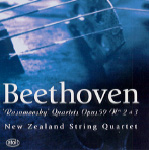Even if you already have a favorite set (or two!) of Beethoven quartets in your collection, you just might want to add these beautifully played, consistently exciting, and musically gratifying performances of the last two Op. 59 quartets as a complement to those enduring staples that reside comfortably on your shelf. In fact, after you listen to this offering from the New Zealand String Quartet you may find yourself popping this disc in your player more often than you thought you would.
This is simply great Beethoven, where thematic and tempo relationships are clearly and intelligently thought out and articulated, and where communication among players reaches the highest level of artistic expression. The quartet’s precision in little details, so important in Beethoven, shows the collective workings of players who’ve spent years together, living this music and learning to work as one multifaceted body. The tricky interactions among the instruments in the Adagio of No. 2, with the contrasts of lyrical lines and sharply marked bowing, changing dynamics and textural effects provide sufficient evidence of this group’s world-class stature. This difficult movement comes off as interpretively eloquent and technically assured as you’ll find from any of the “big-name” quartets.
The New Zealanders (violinists Helene Pohl and Douglas Beilman, violist Gillian Ansell, and cellist Rolf Gjelsten) choose tempos somewhat slower than the reference Melos and Smetana quartets, but the results prove that it’s energy, movement, the nature of attacks and releases, and dynamics–not sheer speed–that make a performance’s impression. Where the Melos sometimes seems rushed and frantic in the allegros–an uncomfortable feeling for listeners–the New Zealand ensemble is in complete command, and you actually believe the tempo is faster than it really is. Also impressive is the opening to No. 3, where the ensemble emerges from the harmonically ambiguous, rhythmically swampy intro to create an ideal playful dance, and also manages the long breathed, melancholy mood of the Andante with an engrossingly realized juxtaposition of the darkly dramatic sections and the brief, lilting tension-breaking passages. The Allegro molto finale of No. 3 leaves us with a suitably brilliant, blazing conclusion to a terrific disc. The sound is acceptably close and a bit on the gritty side–no warm, fuzzy Beethoven here! Importantly, the studio recording captures the realistic flavor of this group’s live performances–and only makes us long for a complete Beethoven cycle, which the NZSQ has performed many times in concert. [Editor’s note: New Zealand Quartet CDs may be difficult to find in retail stores in North America, but are available online from the following websites–[email protected] and www.marbecks.co.nz.] [8/23/2003]
































